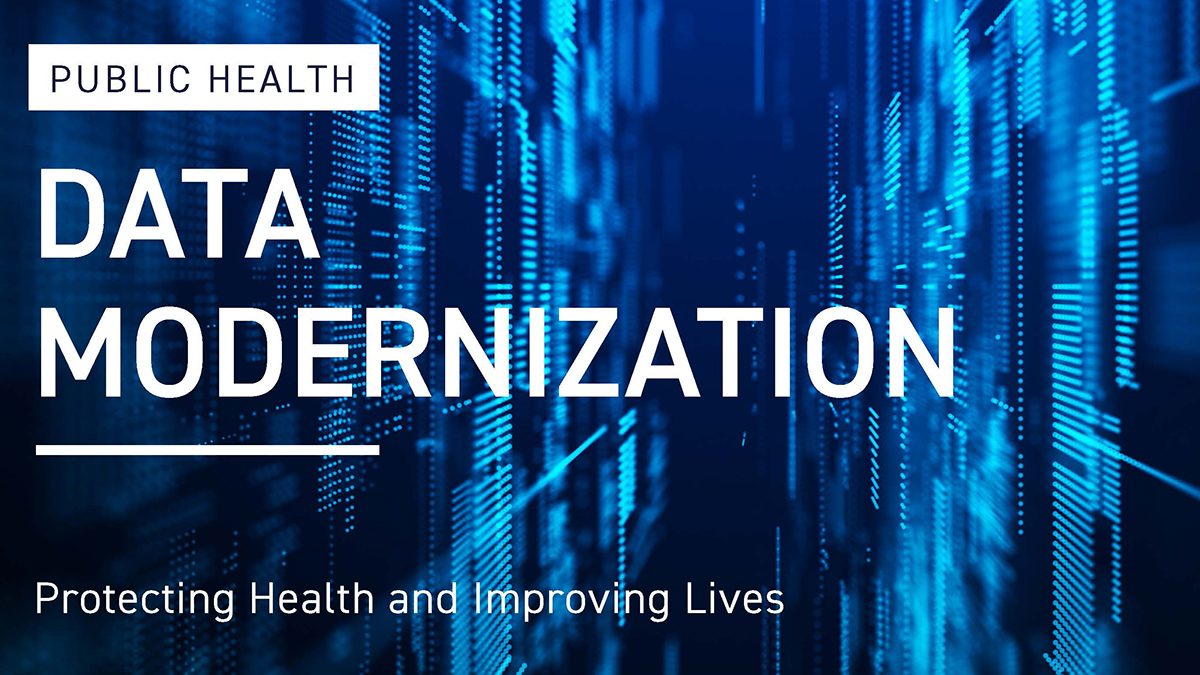At a glance

Data: Foundation of Public Health
In public health, data isn't just numbers—it's the foundation of our ability to understand, save lives, and improve community health. Often described as the "oxygen" powering our public health system, data guides decisions that impact millions of lives every day.
CDC's Public Health Data Strategy (PHDS) has four public health missions in which data need to meet. Essentially, we need data to:
- Detect and monitor
- Investigate and respond
- Inform and disseminate
- Be response-ready
Data is our most powerful tool in public health. Yet, as new technologies emerge and health challenges evolve, the need to modernize our data systems grows more urgent. This is where data modernization steps in.
Why Modernizing Data Matters
Data modernization is a top priority for CDC. Just as we improve roads and bridges to meet changing demands, we must also enhance our data systems to keep pace with the evolving needs of public health and the technological advances at our fingertips.
Consider this: a decade ago, the idea of merging public health with healthcare and analyzing real-time data for decision-making seemed out of reach. Yet, today, it's a reality.
These advances led to groundbreaking changes in public health. For example, laboratories and public health professionals now utilize advanced data analytics and cloud-based solutions to tackle emerging health threats in ways that were unimaginable just a few years ago.
Modernizing data isn't just keeping pace with the present—it's about preparing for the future. By leveraging innovations like machine learning and innovating data sharing capabilities, we unlock new insights, streamline processes, and respond more effectively to emerging health challenges.
Here are some ways that data modernization is making a difference.
Modernization in Action
Why it Matters
Empowering Individuals
Sharing Data and Guidance on the 2023-2024 Respiratory Threat Season
New CDC data channels greatly improve public understanding of health threats, helping individuals and communities make informed decisions.
Supporting Healthcare
Reducing Data Reporting Burden
Electronic case reporting reduces the reporting burden on healthcare providers, enabling faster public health responses and improved community health outcomes.
Timely Diagnosis and Treatment
Unpacking the Science: How NPCR is Working to Get Cancer Data Faster
Faster data collection and analysis are crucial for improving early diagnosis and treatment options for childhood cancer, significantly enhancing outcomes for young patients.
Faster Detection and Response
Outbreak Response: Real-Time Data for Emergencies
Real-time data technologies enable swift CDC actions during health emergencies, significantly reducing response times.
Answering Complex Questions
Linked Data Answers America’s Complex Health Questions
Linking diverse health datasets provides essential insights that shape effective national policies.
Promoting Health Equity
Looking at AI’s Potential Impact on Health Equity
Advanced analytics and artificial intelligence (AI) quickly analyze complex health patterns that reduce health disparities.
The Road to Modernization
The road to modernization at CDC has been a strategic progression, beginning with the Surveillance Strategy in 2014, which established a systematic approach to data collection and analysis. Building on this foundation, the Data Modernization Initiative (DMI) was launched in 2019, providing structured funding and a strategic framework to enhance health data systems further. This initiative paved the way for the Public Health Data Strategy (PHDS) launched in 2023 by the Office of Public Health Data, Surveillance, and Technology (OPHDST), which further refines and expands upon the advancements initiated by these foundational efforts.
Together, these significant steps demonstrate CDC's ongoing commitment to using data strategically to improve public health outcomes. Data modernization is not a one-time event. Each step is a continuous journey towards advancing data for more effective and informed public health action.
For a detailed look at the milestones in CDC's modernization journey, visit the Notable Milestones page.
Future State: A One Public Health Approach
Over the next 5 years, we are hyper-focused on achieving public health and healthcare interoperability. This future state will lead to:
- Near real-time reporting and investigation of novel and serious health threats
- Faster detection of common public health threats and outbreaks
- Better insights into chronic disease conditions and trends
- Nationwide real-time monitoring of public health threats
- Faster sharing of information back to healthcare, improving clinical decision-making and patient safety
In shaping the public health vision for data modernization, we remain agile, avoiding a commitment to any single approach. Rapid technological changes mean today’s innovations could soon be standard, so by staying adaptable and embracing new ideas, we ensure our data modernization efforts keep advancing public health effectively.
Get to Know Data Modernization
Data modernization is a dynamic and ongoing process. The resources listed below provide insights into the history, funding, policies, technology, and collaborative efforts that shape CDC’s modernization initiatives.
- Data Modernization Initiative (DMI): Funded by congressional and emergency allocations, DMI's foundational efforts have reshaped public health data for enhanced surveillance and response since 2019.
- Public Health Data Strategy (PHDS): Launched in 2023, this strategy accelerates DMI priorities and commits to focused goals and measurable milestones to accelerate public health outcomes.
- Data Policies and Standards: Establishes guidelines to ensure the secure and effective use of public health data.
- Technologies: Advances in technology drive the future of public health data management and analysis.
- Partnerships: Facilitates innovative collaborations to advance data modernization.
- Data Modernization in Jurisdictions: Showcases how local and state jurisdictions are implementing modernization practices.
- Data Modernization in Action: Highlights real-world applications and impacts of data modernization.
